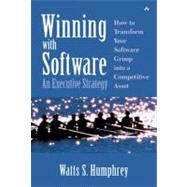
Note: Supplemental materials are not guaranteed with Rental or Used book purchases.
Purchase Benefits
What is included with this book?
Known as “the father of software quality,” Watts S. Humphrey is the author of numerous influential books on the software-development process and software process improvement. Humphrey is a fellow of the Software Engineering Institute (SEI) at Carnegie Mellon University, where he founded the Software Process Program and provided the vision and early leadership for the original Capability Maturity Model (CMM). He also is the creator of the Personal Software Process (PSP) and Team Software Process (TSP). Recently, he was awarded the National Medal of Technology—the highest honor given by the president of the United States to America's leading innovators.
| Preface | p. xi |
| Every Business Is a Software Business | p. 1 |
| The Principles of Software Management | p. 2 |
| Why Every Business Is a Software Business | p. 4 |
| We're in the Hardware Business | p. 5 |
| Maintain Control of Product Uniqueness | p. 7 |
| Quality Is More Important Than Schedule | p. 8 |
| In Software, What Must Happen Often Does Not | p. 10 |
| A Quality Commitment | p. 11 |
| Summary and Conclusions | p. 13 |
| References | p. 14 |
| Why Projects Fail | p. 15 |
| The Crash Project That Almost Crashed | p. 15 |
| The Causes of Project Failure | p. 17 |
| The Executive Role in Project Failure | p. 24 |
| Summary and Conclusions | p. 26 |
| Reference | p. 27 |
| Rational Management | p. 29 |
| Facing Facts | p. 29 |
| Cutting Cycle Time | p. 30 |
| You're Ruining the Business | p. 32 |
| Getting the Facts | p. 33 |
| The Flight-Test Deadline | p. 36 |
| The Essence of Rational Management | p. 37 |
| Summary and Conclusions | p. 39 |
| Why Quality Pays | p. 41 |
| Poor-Quality Software Can Be Life-Threatening | p. 41 |
| Quality Work Saves Time and Money | p. 43 |
| Defect-Removal Strategies | p. 45 |
| Quality Work Is More Predictable | p. 47 |
| If You Don't Manage Software Quality, Nobody Else Will | p. 47 |
| Summary and Conclusions | p. 50 |
| References | p. 50 |
| Leadership Goals | p. 51 |
| Faster, Better, Cheapter | p. 51 |
| Fixing Software in an Organization | p. 53 |
| Establishing the Goal | p. 53 |
| Accelerate the Work, Not Just the Schedule | p. 54 |
| Improving Quality | p. 57 |
| Cutting Costs | p. 58 |
| Improving Task Time | p. 60 |
| Defining Responsibilities | p. 62 |
| Summary and Conclusions | p. 63 |
| References | p. 64 |
| Changing Engineering Behavior | p. 65 |
| What, Not How | p. 66 |
| Disciplined Software Practices | p. 67 |
| Convincing Others | p. 69 |
| The PSP Course | p. 70 |
| Coming Full Circle | p. 74 |
| Summary and Conclusions | p. 75 |
| References | p. 76 |
| Building Motivated Teams | p. 77 |
| The EBS BrokerNet Team | p. 77 |
| Developing the TSP | p. 78 |
| How to Build Motivated Teams | p. 79 |
| The Teradyne Team | p. 80 |
| The Final Result | p. 83 |
| How Do You Motivate Teams? | p. 84 |
| Building Committed Teams | p. 84 |
| The EBS Results | p. 86 |
| A Trusting Environment | p. 87 |
| The Consequences of Impossible Dates | p. 87 |
| Maintaining Team Commitment | p. 88 |
| Summary and Conclusions | p. 89 |
| Reference | p. 90 |
| The Benefits of Teamwork | p. 91 |
| Better Predictability | p. 91 |
| Shorter Cycle Time | p. 92 |
| Reduced Development Costs | p. 94 |
| Improved Product Quality | p. 95 |
| Reduced Employee Turnover | p. 97 |
| TSP Introduction Costs | p. 98 |
| Return on Investment | p. 99 |
| Discounted Return on Investment | p. 100 |
| Summary and Conclusions | p. 102 |
| References | p. 102 |
| Next Steps | p. 105 |
| The Seven Transformation Steps | p. 105 |
| The Action Plan | p. 110 |
| Summary and Conclusions | p. 112 |
| The TSP Process | p. 115 |
| Launching a TSP Project | p. 123 |
| Reviewing a Project Plan | p. 133 |
| The Quarterly Project Review | p. 157 |
| The Standard-Stage Review | p. 177 |
| Return on Investment | p. 197 |
| Index | p. 213 |
| For Additional Information | p. 231 |
| Table of Contents provided by Syndetics. All Rights Reserved. |
The New copy of this book will include any supplemental materials advertised. Please check the title of the book to determine if it should include any access cards, study guides, lab manuals, CDs, etc.
The Used, Rental and eBook copies of this book are not guaranteed to include any supplemental materials. Typically, only the book itself is included. This is true even if the title states it includes any access cards, study guides, lab manuals, CDs, etc.